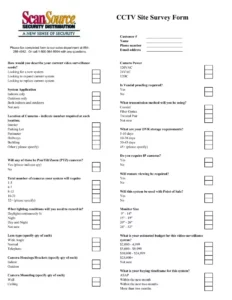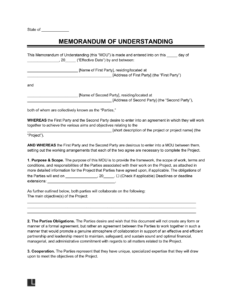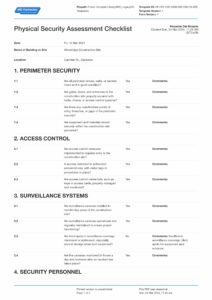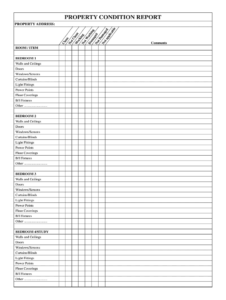In today’s interconnected world, where security concerns often lead to the installation of surveillance systems, it’s becoming increasingly important to establish clear guidelines for their use. Whether you’re managing a residential complex, a commercial property, or even a shared community space, deploying security cameras without a proper agreement can lead to misunderstandings, privacy issues, and disputes among stakeholders. That’s where a clear, mutually agreed-upon document comes into play.
A well-drafted memorandum of understanding (MOU) serves as the foundational stone for any collaborative effort, outlining the roles, responsibilities, and expectations of all parties involved. When it comes to surveillance, having a comprehensive security camera memorandum of understanding template can save a lot of headaches down the line. It ensures everyone is on the same page regarding installation, operation, data handling, and privacy, fostering a transparent and trusting environment.
Why a Security Camera Memorandum of Understanding (MOU) is Essential
Installing security cameras, while primarily intended to enhance safety and deter crime, involves navigating a delicate balance between security needs and individual privacy rights. In environments with multiple stakeholders, like an apartment building, a business park with shared facilities, or a neighborhood watch program, who owns the cameras, who can access the footage, and how long is data retained? These are just a few questions that can quickly become points of contention without a clear, written agreement.
An MOU acts as a non-binding but highly influential framework that guides the behavior and expectations of all parties. It isn’t just about legality; it’s about fostering cooperation and preventing disputes before they arise. By documenting every aspect of the security camera system, from its purpose to its potential limitations, you create a shared understanding that reduces ambiguity and builds confidence among those under surveillance and those operating the system.
Without such a document, you risk facing numerous challenges. Imagine disagreements over funding for maintenance, requests for footage access that clash with privacy policies, or debates about where cameras should be positioned. These issues can strain relationships, erode trust, and even lead to the costly removal or reinstallation of systems. A thoughtfully prepared MOU anticipates these scenarios and provides pre-agreed solutions.
Ultimately, a memorandum of understanding provides a blueprint for responsible surveillance. It transforms what could be a source of conflict into a tool for community safety and accountability. When crafting such a document, it’s crucial to consider a range of factors that will define the scope and operation of your security system. Here are some of the key components you should certainly include:
Key Components to Include in Your MOU
- Purpose and Scope of the Installation: Clearly define why the cameras are being installed and what areas they cover.
- Parties Involved and Their Roles: Identify all individuals or entities involved and their specific responsibilities, e.g., installation, maintenance, monitoring.
- Privacy Considerations and Data Protection: Outline measures to protect privacy, including anonymization, masking, and general data protection regulations.
- Access to Footage and Review Protocols: Specify who can access recorded footage, under what circumstances, and the process for reviewing it.
- Data Storage and Retention Policies: Detail how long footage will be stored, where it will be stored, and when it will be deleted.
- Maintenance and Upgrade Responsibilities: Clarify who is responsible for the upkeep, repairs, and potential future upgrades of the equipment.
- Dispute Resolution Mechanism: Establish a process for resolving any disagreements that may arise regarding the camera system.
- Term and Termination Clauses: Define the duration of the agreement and conditions under which it can be terminated or renewed.
Customizing and Implementing Your Security Camera MOU
While a security camera memorandum of understanding template offers a fantastic starting point, it’s vital to remember that every situation is unique. What works perfectly for a small retail store might not be suitable for a large residential complex with hundreds of residents. Therefore, the customization phase is perhaps the most critical. You’ll want to gather input from all relevant stakeholders, discussing their concerns, expectations, and any specific requirements they might have. This collaborative approach ensures that the final document truly reflects the needs and consensus of everyone affected.
Once you have a draft tailored to your specific circumstances, don’t rush the signing process. It’s highly recommended to have the MOU reviewed by legal counsel. This step helps ensure that the document complies with all applicable local, regional, and national laws concerning privacy, data protection, and surveillance. A legal review can identify potential pitfalls or areas where the language might be ambiguous, safeguarding all parties from future legal challenges and ensuring the agreement is robust and enforceable where necessary.
Beyond signing, successful implementation hinges on clear communication and ongoing commitment. All individuals affected by or involved in the security camera system should receive a copy of the final MOU and have its contents explained to them. Regular check-ins or reviews of the MOU might also be beneficial, especially if there are significant changes in technology, personnel, or community needs. This proactive approach ensures the agreement remains relevant and effective over time, continuing to serve its purpose of providing clarity and fostering peace of mind.
Establishing clear guidelines for security camera usage is not just a best practice; it’s an essential component of responsible community management. A thoughtfully developed and mutually agreed-upon memorandum of understanding provides a foundation of trust and transparency, minimizing the potential for conflict and maximizing the benefits of enhanced security.
By leveraging a robust security camera memorandum of understanding template, you can proactively address complex issues, ensure all stakeholders are informed, and create a safer, more harmonious environment for everyone. It’s an investment in clarity that pays dividends in peace of mind and operational efficiency.



